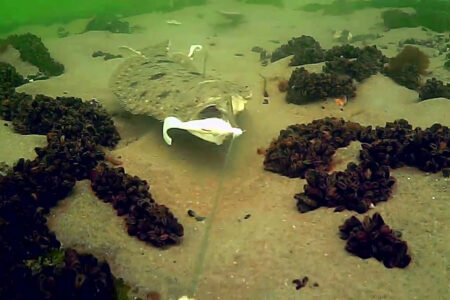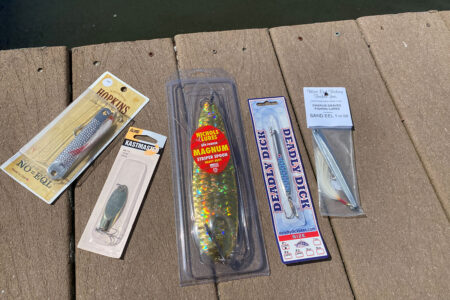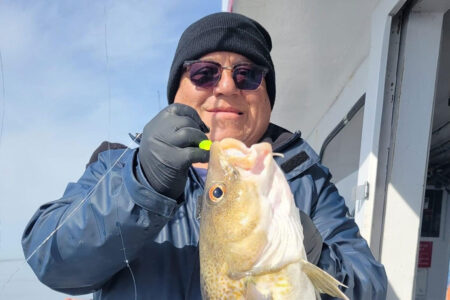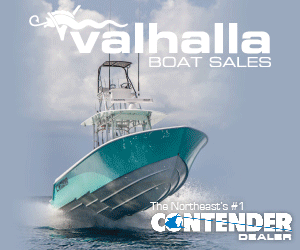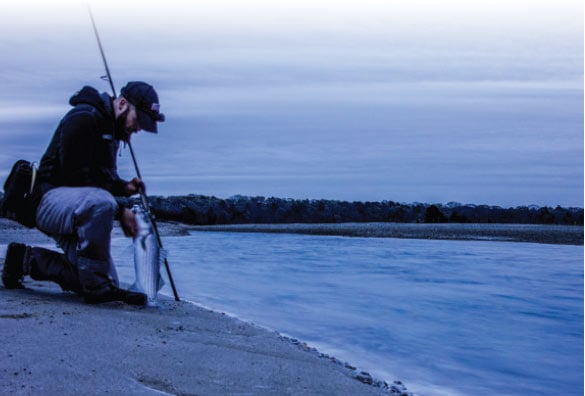
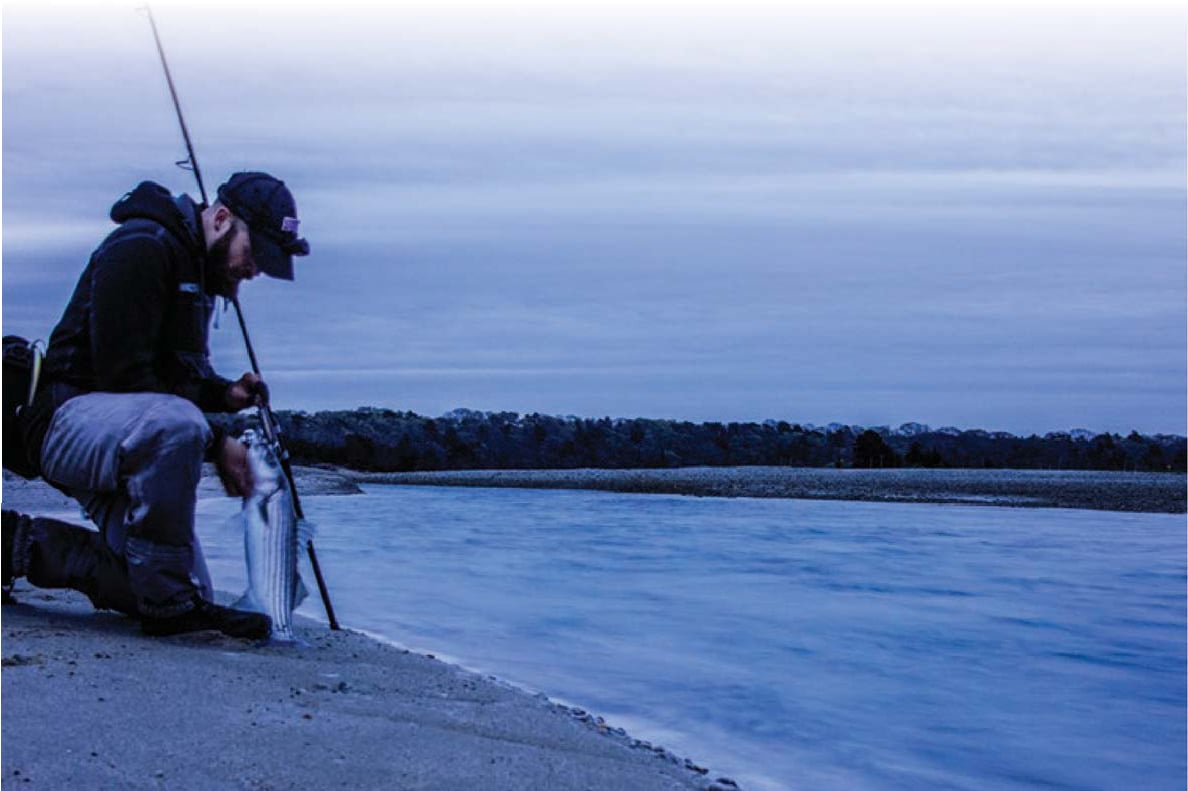
Score big while fishing from a small spot this fall.
What is a good night of striper fishing? For some guys, it’s nailing a dozen schoolies. For others, it’s an epic fight in heavy surf with a single 40-pounder. For me, it’s consistency in my catch. Put another way, I find it gratifying when I make a plan and accurately predict that fish will be “there”- reeling them in is just a bonus (albeit a significant one.) This is a simple enough concept, but it is exceedingly difficult in practice.
There are many factors in being a consistent angler, but one way to mitigate extraneous variables and dial-in consistency is to leverage reliable structure. There are many different structure types; however, I find there is one that is extremely reliable that is vastly underappreciated. I refer to these as “micro-inlets.” In the context of this article, think of micro-inlets as small tidal openings which flow directly into the ocean. They come in various forms and sizes—they can be made by estuaries, streams, ponds, etc.—but are generally less than 75 feet across and shallower than 10 feet deep. Our eastern shores are dotted with thousands of these pieces of structure.
As the name micro-inlets suggests, they are small in form, but I’m here to tell you they harbor huge in potential. I more or less stumbled upon my first micro-inlet at the earlier stages of my fishing career. I had been fishing a lot of sand beach that year, and I decided I wanted to try something totally different. The only thing that attracted me to this particular micro-inlet was easy access; I had never fished a spot like this before. However, I will never forget that first season fishing the outflow; I went from catching roughly 100 fish the entire previous season, to catching over 250 from that one tiny spot alone!
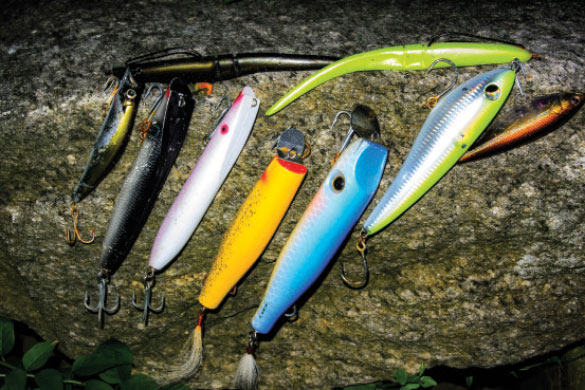
Today, while every year is different, I still expect my local micro-inlets to give up as much as 50% of my total catch for the season. They’re generally not trophy spots, but they can produce fish much larger than you would expect. After all, these are the nurseries for much of our inshore fishery and are magnets for fish of all sizes. When conditions line up perfectly, I anticipate up to a week with every night exceeding 20 fish, and at least a few fish into the teens or even deep into the 20-pound range—my best remains a solid 30-pounder pulled from water no more than 5 feet deep. If I catch less than a dozen fish on any given night, I leave disappointed. And the best part is, that rarely happens; these spots really have that degree of consistency.
Micro vs. Traditional Inlet – What’s Different?
I think one of the mistakes many make when they try and fish these small, shallow pieces of structure is that they look at it like a large inlet, and just scale down their offerings and tactics. But your local micro-inlet is not just a smaller version of Moriches, Jamestown or Barnegat. The combination of shallow water and weak currents often make them fish more like open surf than inlets. Having spent time fishing both types of structure, here are a few things that I’ve learned to help dial-in consistency.
The first thing that really sets micro-inlets apart is that they almost always only produce on the outgoing tide. In my experience there just isn’t enough structure or depth to hold fish on the inside of these tiny breaches. I’m not saying it’s not possible to catch fish on the incoming at these spots, but I’ve yet to find one that produces anything but rats on the incoming. Eliminating the incoming tide as an option helps with consistency and maximizing your time on the water as you can spend the incoming tide elsewhere.
Next, you can leave the heavy lead at home. Even if the micro-inlet is 10 feet deep, because they generally have small quantities of water moving in and out, the currents are not strong enough to warrant the use of even moderatesized bucktails. Yes, you can and should try bucktails, but I find they are not as effective as other plugs. One micro-inlet I fish is about 15 feet deep during an extreme moon tide, yet I find I can’t even fish a 1-ounce bucktail effectively. And this is a rare spot; the others I fish max out at about 6 feet deep— even a ½-ounce jig is often too much.
The last and perhaps most important tip I can give about fishing micro-inlets is this: fish them at the extremes of tide height. In my experience, this trumps every other factor in turning on a bite. Wind, weather, and bait can matter, but tide height is of the utmost importance. You can find tide height on most tide charts and they range drastically based on the area. I find that small fish can be in the outflow any of the night tides, but it takes extreme water flows to draw-in larger fish. It’s easy to explain with a hypothetical example. Let’s say your local area has a tide height ranging from 2.1 to 4.2 feet at high-tide. You may find that the micro-inlet is absolutely dead at tide heights less than 3.5, and the largest fish are caught at heights over 3.9 feet. This often means fishing around the moons, and even skipping entire tide cycles. I think the reasons for this are three fold: 1) the increase in water depth brought about by large tides makes big fish “comfortable” and they come inshore knowing they have more water over their heads; 2) the higher tide heights flush out more bait and have a higher potential for a good feed for these fish; and 3) many species of bait fish (eels, herring, silversides, etc.) move in and out of these microinlets to breed around the extreme moon tides.
Micro vs. Traditional Inlet – What’s the Same?
There are a couple things you can carry over from fishing traditional inlets. First, water temperature is extremely important; second probably only to tide height. In the spring, these micro-inlets can be the first places to produce on days where the difference between air temperature and water temperature in the ocean are extreme. For example, on a sunny day in May where the air is 80 degrees, the water in the little outflow might be 65 and the ocean may still be 48. The opposite can occur in the fall with Nor’easters cooling the backwaters far below ocean temperatures. These significant differences seem to call both predator and prey into these small pieces of structure with shocking consistency. My best nights at micro-inlets tend to be in the earliest stages of migration (in my area early May) and then again at the beginnings of the fall migration (usually September into October.) As a side bar to this, I also prefer wind coming into the inlet. I don’t need a screaming gale, but if it’s a moderate breeze it can help create soft structure and standing waves that hold bait in tight to the micro-inlets, which helps attract predators. Finally, just like the big inlets, you should be fishing microinlets at night. In fact, it’s almost assuredly more important to fish these places in the dead of night than any of the big breaches. Shallow water makes predators spooky and finicky, and if you can find a night tide with all the right ingredients, the chances of you catching quantity and quality will increase dramatically.
Putting all of this together, first I’m always looking at the tide height and finding a big tide that also falls well after dark. I’d also like it to be a warmer day in the spring and colder in the fall. If I can get these three factors together, I am confident I’ll have success, and use this knowledge and confidence to produce increased consistency.
When It Comes to Tackle – Keep It Simple
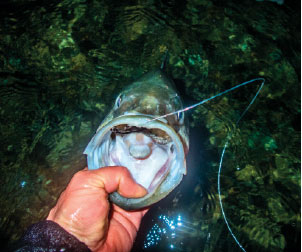
Fishing micro-inlets is relatively simple, and therefore I think they’re great learning areas and places for beginners to hone skills they can use elsewhere. In terms of tackle, I am a staunch supporter of fishing gear capable of handling the exceptional fish, not the average. Therefore, I prefer an 8.5- to 9.5-foot rod rated to about 3 ounces that is capable of handling the occasional 25-pound fish. As far as plugs, I keep it simple. I fish 7- to 14-inch soft plastics like Lunker City Slug-Gos and Hogy Originals 80% of the time in these spots. I like to rig them weight-less with the largest swimbait hook I can find. Beyond Slug-Go and Hogy lures, I like to use Super Strike Zig-Zag and Northbar Montauk darters, especially at the early stages of the outgoing when the water is deepest. Further, I also always pack a couple glide/stick baits. There are numerous companies that make them, but I prefer Savage Gear and Sebile. Since I am always looking to score a cow, I’ll often carry a metal lip of at least 2 ounces with me as well. There’s about 200 different kinds that all swim differently, but a 2.5-ounce Gibbs Danny is a good compromise in size, cost and action for working the current seams.
Finally, I like Yo-Zuri Mag Darters, and while I don’t consider them trophy catchers they do catch fish of all sizes. I no longer fish eels for a variety of reasons, but rigged and dead eels can also be effective in these locations, and my largest fish to date from a micro-inlet came on a riggie so don’t rule them out if you like to fish them.
| SCORE BIG IN MICRO-INLETS |
|---|
|
1. BACK UP! At many of these spots you can walk right up to them and practically drop your plug into the water, but this is not usually the most effective method. I find it’s often best to back up onto dry ground so that I can swing my offering in the current, right up to the edge of the shore—sometimes I stand as far back as 30 feet to get the proper presentation! 2. LEAVE THE SMALL STUFF AT HOME. Just because these are small spots, doesn’t mean you should be throwing little jig head/rubber combos. Medium to large metal lips, darters, and big soft plastics can be highly-effective, and you might be surprised what’s swimming in 3 feet of water. 3. STAY UP LATE. Because these spots are shallow and small, it’s best to fish them in true darkness—not sunset or false dawn. I have had my best catches late in the night. Don’t be afraid to fish well after midnight! |
